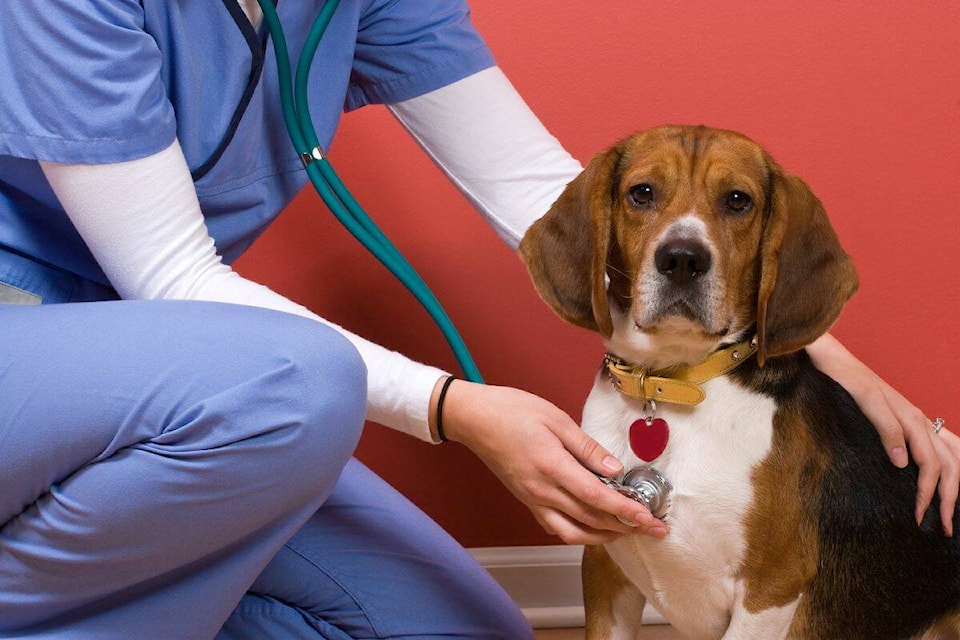Gabrielle Chaisson, 17, has always known that she’d like to work with animals. And when a new opportunity came up through her school to do so, she jumped on it.
Thanks to a $50,000 grant from the Alberta government, the 2022/2023 school year is the first year Chinook’s Edge School Division has been able to offer the veterinary technical assistant (VTA) certificate program through dual credit, working in conjunction with Olds College. With this option, students can graduate from Olds College at the end of the school year with a VTA certificate and either begin working in that role straight out of high school or use the certificate as a building block for further post-secondary education in the animal sciences industry, such as going on to earn a veterinary medical receptionist certificate or an animal health technologist (AHT) diploma. For students looking at even higher education, the University of Calgary’s doctor of veterinary medicine (DVM) applicant manual explains that related experience or other means, such as achieving a veterinary technical assistant certificate, can bolster an applicant’s chances of getting in. All AHT programs in Alberta also require work experience or volunteer hours to get in.
“The VTA certificate would look fantastic on a resume and allow you to get work experience or an internship with a veterinary clinic,” reads the program information sheet that Darla Bell, off-campus programs assistant with HJ Cody School in Sylvan Lake, gives to interested students. “This work experience would also benefit them in terms of confirming that they want a career in animal health before they commit to a longer program like AHT or the DVM program.”
Students in the VTA dual credit program have five courses to complete: introduction to the veterinary profession, small animal restraint and handling, principles of veterinary clinical procedures, veterinary equipment and instrumentation and veterinary patient preparation and husbandry. The program is split between online learning, both flexible and at set times, and on-campus learning at Olds College. This same program is available to adult students after high school, at a cost of about $3,700, but by doing it through high school and dual credit, the cost is covered by the school division. However, students do have to pay for their own learning materials and personal protective equipment for about $350.
Chaisson, who is in grade 12, is the only student at HJ Cody participating in this new program. Last year, she was able to take single courses offered through dual credit: the introduction to the veterinary profession course and a course called team approach to veterinary medicine.
“I wanted to take it because I knew I wanted to do something in the animal health industry,” Chaisson said of the VTA program. “But I wasn’t quite sure if it would be for me, so I wanted to try it out and see.”
Chaisson said she has really been enjoying the program so far.
“We really get to try out and do more hands-on work than we were able to do with the online courses,” she explained. “When I graduate in June, I’ll be a fully certified VTA. After that, I’m planning to go back to Olds College next year and become a registered RVT.”
Before enrolling in dual credit and taking this VTA program, Chaisson said she was picking high school classes only in order to graduate.
“I had to pick classes that I wasn’t really interested in, just to earn credits,” she explained. But now I have more credits than I need to graduate. Now I’m more engaged in it too, because it’s stuff I want to learn about, rather than taking courses just because I have to.”
Chaisson said she recommends the dual credit program, if there’s a career a student is interested in and they want to try it out.
The change from high school student to college student hasn’t fazed Chaisson at all.
“I really like it,” she said. “It’s more independent and you’re focused on learning the material, and I found I’ve had more time to understand the material. In high school, the majority of the grade is assignments. In college, it’s actually understanding the material and doing well on mid-terms and final exams, rather than assignments.”
Chaisson lives on an acreage outside of Sylvan Lake and she grew up riding horses.
“I’ve always really loved animals. This gave me the opportunity to know that this is where I want to go.”
